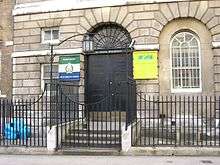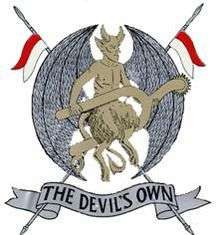Inns of Court & City Yeomanry
| Inns of Court & City Yeomanry | |
|---|---|
| Active | 1961–present |
| Country |
|
| Branch |
|
| Type |
Signals Music |
| Role |
National Communications Music support |
| Size | 2 Squadrons |
| Part of |
Royal Corps of Signals Corps of Army Music |
| Nickname(s) | The Ice Cream, Chocolate and Eclair Yeomanry |
| Motto(s) | Salus Populi Suprema Lex ([our] paramount law is the wellbeing of the people) |
| Colours | Guidon |
| Mascot(s) | The Devil with spur |
| Battle honours | South Africa 1900–02, France and Flanders 1918, Gallipoli 1915, Gaza |
| Insignia | |
| Identification symbol | Arms of the four Inns of Court overlaid by Arms of the City of London |

The Inns of Court & City Yeomanry is a British Army unit formed through the amalgamation of The Inns of Court Regiment (The Devil's Own) and The City of London Yeomanry (Rough Riders) in 1961. Its lineage is maintained by 68 (Inns of Court & City Yeomanry) Signal Squadron and the Band of the Royal Yeomanry (Inns of Court & City Yeomanry).

History

Foundation
The Inns of Court & City Yeomanry (IC&CY) was formed only in 1961, through the amalgamation of The Inns of Court Regiment (The Devil's Own) and The City of London Yeomanry (Rough Riders). But it can trace its direct roots back at least to the first written records of the former in 1584, when 95 members of The Inns of Court entered into a solemn pledge to defend Queen Elizabeth I against the threat of Spain's Armada.[1]
Just like today, many volunteers were recruited among the legal community at times of national peril, and so it was at an inspection in Hyde Park in 1803, during the Napoleonic Wars, that George III is reputed to have styled such a litigious body as 'The Devil's Own' – a title that lives on today.[1]
By mid-nineteenth century, the Inns of Court Regiment (ICR) had evolved from a Volunteer Rifle Corps. The other half of the unit, The City of London Yeomanry, was raised from volunteers of the 20th Battalion Imperial Yeomanry only in the late 1890s, and served with distinction in the Second Boer War in South Africa. Its nickname, The Rough Riders was taken from a famous body of volunteer horsemen who fought in the Spanish–American War of 1898.[2]
1960s defence reforms
During the period prior to 1967, the IC&CY served as an armoured car regiment (as did many other Yeomanry units). The 1967 reorganisation of the TA then led to the regiment being reduced to an infantry company, and assigned as A Company (Inns of Court and City Yeomanry), the London Yeomanry and Territorials.[3]
In 1968, the London Yeomanry and Territorials was disbanded, but a cadre of the regiment, consisting of three officers and five other ranks, was retained in the Royal Armoured Corps, thereby ensuring the continuation of the Regiment's name in the Army List, and the retention of its headquarters and historical mess at Lincoln's Inn. Personnel from A Company were then used to form 68 (Inns of Court and City Yeomanry) Signal Squadron, in the newly formed 71 (Yeomanry) Signal Regiment.[3]
The Home Service Force
A Home Service Force Squadron was badged as IC&CY and designated as 348 (IC&CY) Signals Squadron HSF from 1986 to 1993. The squadron was based at Lincoln's Inn and wore the original IC&CY cap badge. 348 Squadron was organised on the lines of an infantry rifle company and had a key point defence role. The HSF unit ran on for another 12 months as a semi-official Defence Platoon, its final parade being in 1994.[4]
Merger with the Essex Yeomanry
Following the reorganisation of the Royal Signals Reserves in 2009, 68 (Inns of Court & City Yeomanry) Signal Squadron merged with 70 (Essex Yeomanry) Signal Squadron to form 68 (Inns of Court & City and Essex Yeomanry) Signal Squadron.[5]
Under Strategic Defence and Security Review in 2014 907 Signal Troop was subordinated to 36 Signal Squadron, which then became 36 (Essex Yeomanry) Signal Squadron. 68 Squadron reverted to the name of 68 (Inns of Court & City Yeomanry) Signal Squadron, with a footprint solely inside north London.[5]
Current Structure
Today the organisation consists of the following entities:
- 68 (Inns of Court & City Yeomanry) Signal Squadron[6]
- The Royal Yeomanry (Inns of Court & City Yeomanry) Band
The Signal Squadron operates out of two locations: its HQ is in a Georgian townhouse in Lincoln's Inn, Holborn and more austere post-war premises in Whipps Cross, Leytonstone some 17 kilometers away in East London. The Signal Squadron is a Close Support Squadron within 71 (Yeomanry) Signal Regiment, itself part of the Royal Corps of Signals within the British Army Reserve.[7]
Regimental museum
The Regimental Museum, which contains a variety of records, photographs and other militaria relating to the IC&CY, ICR and COLY, is located at 10 Stone Buildings, Lincoln's Inn, London.[8]
References
- 1 2 "Overview". Inns of Court & City Yeomanry. Archived from the original on 4 June 2014. Retrieved 26 May 2014.
- ↑ "The City of London Yeomanry (The Rough Riders)". Inns of Court & City Yeomanry. Archived from the original on 18 January 2014. Retrieved 26 May 2014.
- 1 2 "The Inns of Court & City and Essex Yeomanry". The Inns of Court & City Yeomanry. Archived from the original on 1 January 2014. Retrieved 26 May 2014.
- ↑ "The IC&CY Home Service Force Squadron". The Inns of Court & City Yeomanry. Archived from the original on 1 January 2014. Retrieved 26 May 2014.
- 1 2 "History". The Inns of Court & City Yeomanry Association. Retrieved 17 November 2017.
- ↑ "68 (Inns of Court & City Yeomanry) Signal Squadron". Retrieved 27 August 2017.
- ↑ "71 (Yeomanry) Signal Regiment". Ministry of Defence. Retrieved 27 May 2017.
- ↑ "Inns of Court and City Yeomanry Museum". Ogilby Trust. Retrieved 26 May 2014.